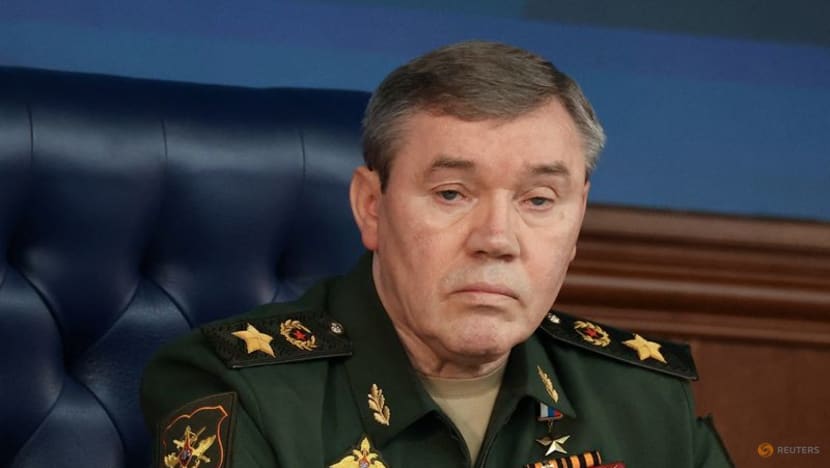Advertisement
CNA looks at how the term originated, historical examples and the implications.

New: You can now listen to articles. 
This audio is generated by an AI tool.
SINGAPORE: Ukraine on Wednesday (Nov 20) said Russia was trying to sow panic and apply “psychological pressure” by circulating fake messages about looming attacks, amid a war between the two countries that has now passed 1,000 days.
The day before, two undersea cables cut in the Baltic Sea in 48 hours led to European and American officials labelling the incident as an example of “hybrid warfare” by malicious actors”, similarly linked to Russia’s invasion of Ukraine.
What is hybrid warfare?
While conventional warfare is generally understood as direct military action, there is no perfect nor fully agreed upon definition of hybrid warfare, which also goes by names such as non-linear warfare or indirect strategy.
The NATO military alliance defines it as a combination of “military and non-military as well as covert and overt means, including disinformation, cyber attacks, economic pressure, deployment of irregular armed groups and use of regular forces”.
These may also include industrial espionage, the use of proxies or insurgencies, diplomatic pressure or even military action that is below the threshold of an armed conflict.
“Hybrid methods are used to blur the lines between war and peace, and attempt to sow doubt in the minds of target populations. They aim to destabilise and undermine societies,” said the North Atlantic Treaty Organization on its website.
What are its origins, and how has it been used?
The concept is arguably as old as war itself.
Ancient Chinese military strategist Sun Tzu once remarked that winning without fighting, or subduing an adversary without relying on military action, is the “acme of skill”.
Both the United States and the Soviet Union employed hybrid warfare during the Cold War, through clandestine sabotage operations among several other tactics.
But Russia’s association with hybrid warfare was solidified in 2013 after military chief Valery Gerasimov published an article noting that the rules of war have changed.
“The role of nonmilitary means of achieving political and strategic goals has grown, and, in many cases, they have exceeded the power of force of weapons in their effectiveness,” he wrote, citing the use of political, economic, informational, humanitarian and other measures in coordination with the “protest potential” of a population.
The ensuing years saw well-documented instances of alleged Russian meddling in American and European elections.
Even before its 2022 invasion of Ukraine, Moscow had denied involvement in aiding pro-Russia separatists in the east. It also initially denied involvement in the annexation of Crimea.
“Hybrid warfare seems to have become an integral part of Moscow’s policy vis-à-vis the West,” researcher Arsalan Bilal wrote in NATO’s magazine earlier this year.

China has also integrated hybrid warfare into its doctrine.
In 1999, two senior Chinese military officers published a book titled Unrestricted Warfare, in which they argued that war would unfold on a “borderless” battlefield, with boundaries between soldiers and non-soldiers now broken down.
“It is no longer possible to rely on military forces and weapons alone to achieve national security in the larger strategic sense, nor is it possible to protect these stratified national interests,” wrote People’s Liberation Army colonels Qiao Liang and Wang Xiangsui.
“We no longer have to be like our ancestors who invariably saw resolution by armed force as the last court of appeals. Any of the political, economic or diplomatic means now has sufficient strength to supplant military means.
“Obviously, warfare is in the process of transcending the domains of soldiers, military units and military affairs; and is increasingly becoming a matter for politicians, scientists and even bankers. How to conduct war is obviously no longer a question for the consideration of military people alone”.
China has also publicly adopted a “Three Warfares” concept referring to psychological operations, media manipulation and legal warfare.
Among numerous instances of these at play over the years was the US arrest of two New York City residents in April last year, for allegedly operating a Chinese “secret police station”. Beijing has denied this, saying the stations existed mainly to provide citizen services.
In September, research by an intelligence company pointed to a Chinese social media influence operation pushing divisive messages ahead of the US presidential election.
Beijing also earlier this month drew a baseline for “territorial waters” around the disputed Scarborough Shoal, its latest salvo in pushing claims in the South China Sea.
“China’s continued use of blurred tactics and quasi-military forces in the maritime domain manifestly demonstrates Chinese use of coercive force in innovative ways,” wrote Frank Hoffman and other analysts in a commentary for the Center for Strategic and International Studies in the US.
“China has been carefully adapting its maritime assets and extending its influence, conducting hybrid or grey zone actions with ‘Chinese characteristics’.”
Why is hybrid warfare on the rise?
In the Cold War, the US and the Soviet Union engaged in hybrid warfare as the two nuclear powers wanted to avoid outright confrontation.
Hybrid warfare provided enough plausible deniability to avoid direct armed retaliation.
After the Soviet Union broke up, Russia found its military might diminished, which only encouraged the further use of hybrid warfare to avoid direct military confrontation with the West.
“What is common in both Russian and Chinese thinking is the core idea of avoiding Western military strengths and attacking its weaknesses – the essence of indirect strategy,” wrote Dr Kumar Ramakrishna, a professor of national security studies at Singapore’s S Rajaratnam School of International Studies, in a paper.
Another advantage of hybrid warfare is the ability for countries and groups to wage war for cheap.
As the costs of conventional conflict in a nuclear era continues to grow, so do the risks of escalation, said experts. As such, countries are even more inclined to engage in hybrid warfare.
“It is much more feasible to sponsor and fan disinformation in collaboration with non-state actors than it is to roll tanks into another country’s territory or scramble fighter jets into its airspace,” wrote Bilal, the researcher.
“The costs and risks are markedly less, but the damage is real.”
One outcome of Russia’s interference in the 2016 US election was mainstreaming of right-wing populism in the US, with erosion of trust in state institutions as a result.
“As right-wing populism contributes towards and intersects with declining trust in mainstream media, disinformation can be employed to create security woes within target states,” Bilal added.
“Russia strategically uses disinformation to achieve political and strategic goals.”
Then there is generative artificial intelligence (AI). It has already become ever more commonplace and easy for nefarious entities to use the tech to spoof credible news platforms and government websites, further eroding trust.
Due to the diffused nature of hybrid warfare, countries may also be unaware they are under attack, leaving them unable to develop a response.
“It is often difficult to fully diagnose an active or recent hybrid threat,” said Bilal.
“The target’s decision-making process may be damaged because a non-attributable force has conducted the hostile action, or there is plausible deniability on the part of the aggressor.
“Polarisation may be deepened on state and societal levels due to disinformation.”
What are the consequences?
China’s actions in the South China Sea, for one, have sparked several confrontations with the Philippines and other countries with overlapping claims.
In one altercation earlier this year, a Filipino sailor lost a thumb in a melee with Chinese coast guard personnel wielding knives and other weapons.
The Philippines and the United States have a mutual defence treaty. That incident could have escalate into a wider direct, armed conflict.
As part of US-China rivalry, a trade war may also lead to a scenario where developing countries face falling export earnings, falling inward investment, higher inflation, higher interest rates and an increased external debt burden as growth slows everywhere.
Away from the superpowers, global markets have also been affected by Iran’s proxy war with Israel, with Houthi rebels in Yemen firing upon civilian cargo ships in the Red Sea and Gulf of Aden.
In Singapore, authorities have periodically warned of hybrid warfare’s threats and implications, amid publicised action taken against foreign actors.
In October, the government blocked 10 websites set up to potentially mount hostile information campaigns, with one of them linked to Russia.
Earlier this year, social media accounts linked to an anti-Beijing Chinese tycoon were blocked after he alleged that Singapore was in the “pocket of a foreign actor”.
This came after a Singaporean businessman with links to China’s top political advisory body was also put on notice for advocating Chinese interests.
In its most recent messaging, Singapore authorities urged the public to be vigilant against moves by malicious foreign actors to sway the population’s sentiments, to advance their own interests.
“They do so by inciting social tension, exploiting societal fault lines, manipulating elections, or undermining confidence and trust in public institutions.”
Want an issue or topic explained? Email us at digitalnews [at] mediacorp.com.sg. Your question might become a story on our site.

